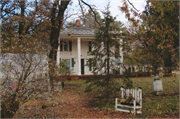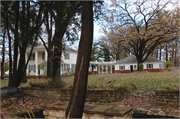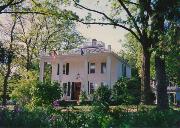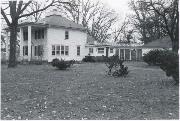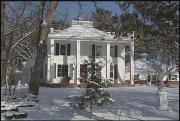Property Record
18224 ERVIN ST
Architecture and History Inventory
| Historic Name: | James Hopkins House |
|---|---|
| Other Name: | Historic Hopkins House and Oak Park Inn Bed and Breakfast |
| Contributing: | |
| Reference Number: | 51902 |
| Location (Address): | 18224 ERVIN ST |
|---|---|
| County: | Trempealeau |
| City: | Whitehall |
| Township/Village: | |
| Unincorporated Community: | |
| Town: | |
| Range: | |
| Direction: | |
| Section: | |
| Quarter Section: | |
| Quarter/Quarter Section: |
| Year Built: | 1897 |
|---|---|
| Additions: | 1924 1946 |
| Survey Date: | 19812013 |
| Historic Use: | house |
| Architectural Style: | Colonial Revival/Georgian Revival |
| Structural System: | |
| Wall Material: | Clapboard |
| Architect: | Harley Hopkins (a)/Albert Engen (b) 1924 |
| Other Buildings On Site: | Y |
| Demolished?: | No |
| Demolished Date: |
| National/State Register Listing Name: | Not listed |
|---|---|
| National Register Listing Date: | |
| State Register Listing Date: |
| Additional Information: | A 'site file' exists for this property. It contains additional information such as correspondence, newspaper clippings, or historical information. It is a public record and may be viewed in person at the Wisconsin Historical Society, Division of Historic Preservation-Public History. This house was originally built on the homestead of James and Angeline Hopkins in Section 6 of Preston Township, Trempealeau County, in 1897. The house was moved to its current location in Whitehall by their son, Florison Hopkins, in 1913. The full front porch was removed from the house at this time. The current estate includes the house, a garage, a carriage house that included Harley Hopkins' art studio, a six room motor inn, and remanants of the Hopkins' rose garden, lilac hedge, tulip beds, a reflecting pond, and a sunken garden. Florison and Nelly Hopkins' son, Harley, graduated from the Art Institute of Chicago in 1923 and worked as a decorator at C.D. Macpherson and as a design colorist at Holabird & Root Architect Firm, both Chicago firms. He provided the designs for all of the alterations to the house and the grounds, inspired by Mt. Vernon and the gardens of Europe. In 1924, Harley added a sunroom to the rear of the house and a large columned portico across the front of the home. The curved loggia appeared sometime prior to WWII. A small kitchen/bath was added to the rear of the home for his mother's 80th birthday. Noted artists John Rood and Peter John Lupori were friends of Harley Hopkins' and provided several sculptures for the gardens. In 1953, the estate was sold to R.L. and Irene McGrath. Mr. McGrath ran his construction company out of the garage and Harley Hopkins old art studio, while Mrs. McGrath operated a beauty salon in the sunroom and screened in porch. In 1960, Irene built a six-room motor inn on the northeast corner of the property and called it the "Garden Motel", which she ran until 1969. In 1993, after years of neglect, the property was purchased by Steve and Mari Moe, who renamed it Oak Park Inn. They converted the garage into three guest rooms and added an unattached garage west of the house in 1995. Steve Sendele and Linda Mossman purchased the property in 1998 and are working to restore the house, the gardens, and the grounds. Set back from the road on a large wooded lot, this relatively imposing structure has a portico with two story square pillars supporting its balustraded roof. Another ballustrade decorates the crest of the hip roof. A port cochere and coach house are attached to the east side. Many of the modifications, which appear to have been made in the 1930's and 1940's, are based on the owners interpretations of the "Williamsburg" colonial motif. The original appearance of the building has been substantially altered. This is the fifth house built on the site by James Hopkins, a Trempealeau County pioneer. In 1946, it was occupied by John Hopkins a colorist, designer, and painter of national note who was a partner in the firm of Holabird and Root in Chicago. The extensive gardens were once of interest. They were planted with formal landscaping and wildflowers, set with sculpture. 2013: The James Hopkins House (AHI No. 51902) is a c.1890 American Foursquare that was extensively remodeled in the Colonial Revival style in the 1920s and 1930s. The two-story frame house is clad in clapboard and has an asphalt-shingled hip roof with a roofline balustrade. The primary (south) facade has a two-story full-width portico with square wood columns. The front door is centered on the facade and has a classical surround featuring a pediment and Doric pilasters. The door is flanked by a large, nine-pane bay window and a pair of nine-over-nine, double-hung wood windows. Other windows on the facade and secondary elevations are nine-over-nine, double-hung wood. On the east (side) elevation is a one-story enclosed porch that was added in the 1930s and currently serves as the lobby for the Oak Park Inn Bed and Breakfast. It is clad in clapboard and brick and covered by a low-pitched shed roof with a roofline balustrade. Attached to the lobby is a curved loggia with a low-pitched roof supported by square wood columns and adorned with a roofline balustrade. The loggia connects the home to a c.1910 one-story carriage house (AHI No. 227010) sided with clapboard and red brick veneer and topped with a steeply-pitched hip roof. Most carriage house windows are six-over-six, double-hung wood sash, but some are one-over-one vinyl replacements. On the northwest side of the property is a six-room motor inn (AHI No. 226193) built in 1960. It is a one-story, rectangular building with one-over-one, double-hung wood sash windows. It is clad in vinyl siding and red brick and has a side gable roof. At one time, the area was extensively landscaped by Johns Harley Hopkins and his mother, Nellie. Some landscape features are extant, including retaining walls and a reflecting pool. One grave marker is located in the gardens behind the house for Ida Mae Van Sickle, a relative of the Hopkins. On the southeast edge of the property, near the road, is a sign that reads “Oak Park Inn,” with a black arrow pointing north towards the motor inn. A vintage bicycle that hangs off the front of the sign by a metal pole was added to the sign c.2000. The Hopkins family, led by John and Mary, arrived in Trempealeau County in 1855. They settled in the town of Preston and established a successful farm. After John and Mary’s deaths, the farm was inherited by their eldest son, James Hopkins, who further developed the property and built the American Foursquare residence. After his death in 1913, his son, Florison, purchased a seven-acre plot of land in Whitehall and relocated the house to that site. At this time, the original one-story, full facade porch was removed. In the late 1920s and 1930s the house was significantly remodeled with the current Colonial Revival details by Florison’s son, Johns “Harley” Hopkins, a graduate of the Art Institute of Chicago. Harley Hopkins, an interior designer, was a partner in the Chicago firm of Holabird & Root. In the 1920s Hopkins was living and working in Washington D.C. and visited George Washington’s home, Mount Vernon. This visit is believed to be the motivation behind the exterior and interior Colonial Revival renovations to the Hopkins House, as he designed the full-facade portico, roofline balustrades, and covered loggia himself. The landscaping was added between World War I and the end of World War II, and was inspired by European gardens Harley Hopkins visited while in the military. After the death of Harley Hopkins in 1953, the home was bought by R.L. and Irene McGrath. In 1960 Irene built the six-unit motor inn building. |
|---|---|
| Bibliographic References: | A. Field Observation. B. Milwaukee Journal, 21 July 1946. Curtis-Wedge, Franklyn and Douglace Price. The History of Trempealeau County. Chicago and Winona H.C. Cooper, Jr & Co Publishing. Several articles in The Whitehall Times, early 1920s. Country Life Magazine, 1930. Milwaukee Journal, January 1931. “Architecture and History Survey: USH 53” WHS project number 13-0879/TR. November 2013. Prepared by Mead & Hunt Inc. Jones, Will. Minneapolis Tribune, October 13, 1946. |
| Wisconsin Architecture and History Inventory, State Historic Preservation Office, Wisconsin Historical Society, Madison, Wisconsin |

